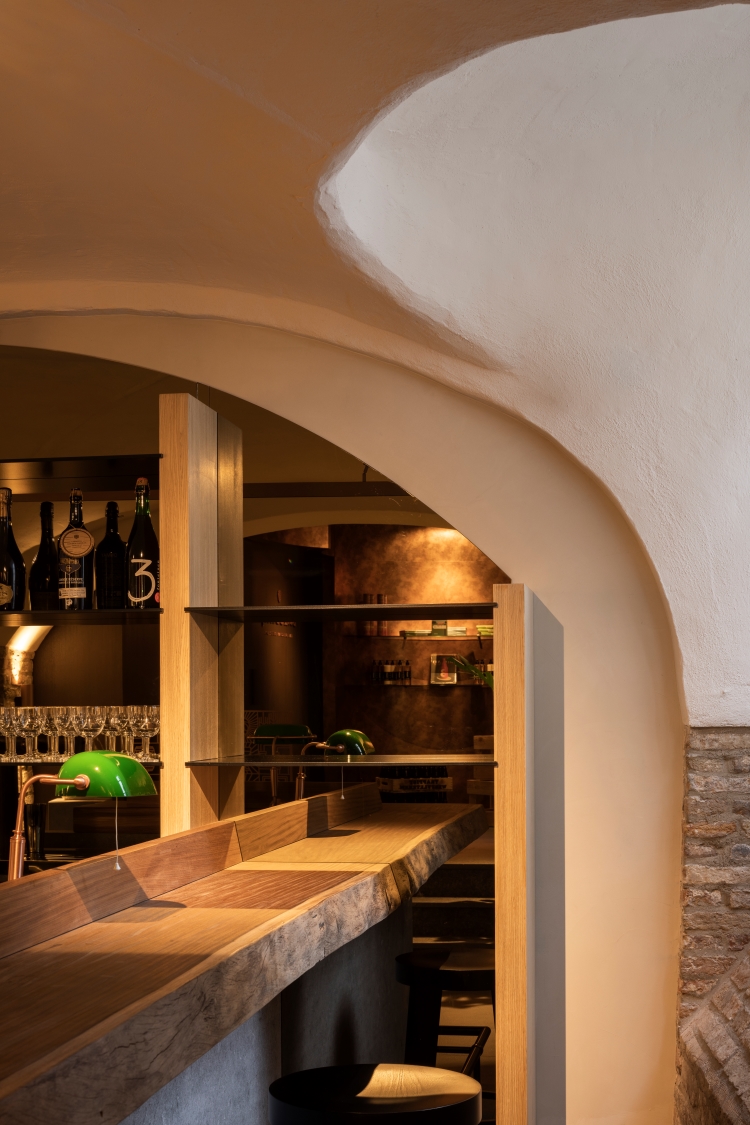Stained glass over stag parties: inside Belgium’s first beer spa
Stained glass windows are a core element of Bath & Barley’s interiors and identity by WeWantMore, referencing Belgium’s history of beer brewing in abbeys.
Belgian beer culture is recognised worldwide and dates back to the Middle Ages when monks began brewing their own beers in abbeys. Beer plays a part in everything from festivals and celebrations to cooking and washing cheese and now, thanks to wellness spa Bath & Barley, you can even bathe in it.
Two Belgian friends Louis Raes and Bart De Brabanter visited one of these experiences in the Czech Republic, which sparked their plan to launch the first Belgian beer spa – Bath & Barley – in the heart of Brussels, followed by a second location in Bruges.

Antwerp-based design studio WeWantMore was brought in from the project’s inception to work on the naming, branding and interior design, tasked with designing a high-end experience that promotes “a sense of relaxation and intimacy” while seamlessly integrating beer, bathing and Belgium’s beer heritage, according the studio’s founder and creative director Ruud Belmans.
WeWantMore had never heard of a beer spa before partnering with Bath & Barley. After some research, the studio found that existing bar spas are “more beer than spa” and that their dark, neon environments created “an overall pub vibe”, drawing in groups like stag parties rather than spa-goers, says Belmans.

What is a beer spa?
Bath & Barley’s offering includes submerging yourself in a traditional oak bubble bath filled with fresh water, hops, barley and yeast, all essential beer ingredients. As well as a beer tap positioned between the baths – from which visitors can pour themselves a glass or two of locally brewed pilsner Estaminet – each private spa room also has a sauna that releases hoppy aromas and a straw bed.
Health benefits are said to come from the hop flower’s Xanthohumol content (a powerful antioxidant), the skin-nourishing yeast and other beer ingredients such as vitamin B, carbohydrates, proteins, essential oils and amino acids. The idea is that the bioactive nutrients are absorbed through the skin while the visitor is submerged in the bath, whereas drinking the locally brewed beverage promotes mental relaxation.

“Sensorial elements”
Bath & Barley Bruges is located within a medieval cellar with dome-like architecture and arches. Belmans explains how WeWantMore sought to create a unique design concept by respecting the “strong, inherent, classic features” of the space while countering it with “a lot of natural shapes and lines”.
Upon entering Bath & Barley Bruges, visitors will find themselves inside a domed room wrapped in copper, inspired by ancient brewing kettles, complete with a dried hop and barley ceiling. This looks to add “sensorial elements” to the spa experience from the beginning, says Belmans, as the hop and barley release their natural aromas into the space.

Down a small set of stairs just below street level sits a classical bar with a solid wooden counter and bluestone base. The corridor to the four spas is marked by a stoned-based, wood-toppedmake-up unit, lit with warm lighting and decorated with dangling hop and barley branches.
Each room has its own shower and restroom accented with copper details and is completed with two to four wooden baths. Within the bathing areas, the ancient technique of building loam walls by hand – one of the oldest technologies for house construction in the world – has been recreated, resulting in rounded patterns on the finished walls that “exude a sense of security and organic harmony”, says Belmans.

Stained glass stories
Visuals that reference traditional beer brewing and its ingredients have been integrated as stained glass partitions, nodding to Belgium’s Monastic brewing history. Belmans explains how they add” colour and identity” to the spaces while reinforcing “the abbey atmosphere in a contemporary way”.
The windows depict scenes of traditional beer brewing featuring a worker known as a cooper – a barrel maker – as well as folkloric elements like the hop devil, which references the tale of a man named Gambrinus who sold his soul to the devil to become the first mortal brewer of beer.

The colour and material palette focuses on natural elements, like the barley ceiling, and details that refer to the brewing process, such as the copper piping. Belmans describes it as “a rather classic palette” but adds that the use of the visuals, minimal copper piping and “contemporary integrated branding elements” result in “a unique and recognisable concept”.
Cues from “age-old knowledge”
The studio recognised the importance of the identity in positioning this new concept and sought to design a brand that ties into “the wellbeing and healing movement”, says Belmans. Like the interiors, the identity takes influence from “the age-old knowledge of beer brewing” performed by monks in abbeys, and the natural beer ingredients, he adds.
Graphic icons have been drawn to reference the stained-glass window visuals in the interiors, appearing on the website to illustrate different aspects of the experience, from the concept and the benefits to the brew itself.

WeWantMore sought to reinforce Bath & Barley’s connection to Belgian beer culture by taking cues from vintage beer packaging design for the wordmark, using a calligraphic typeface called Harbour designed by Gareth Hague and published by Alias Collection, that combines Latin and Germanic typestyles.
-
Post a comment





